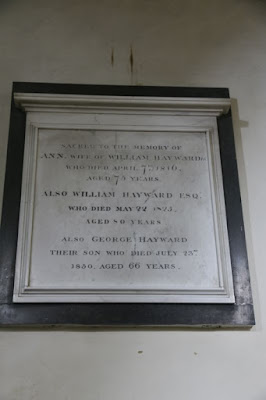St Mary the Virgin dates back to 1120 and was built on the site of an earlier Saxon church. The Norman chancel survives and the aisles are later additions. The font you will see is a rare Norman lead one and was it was later encased in wood, and this preserved it from iconoclastic Parliamentarian soldiers in the 17th century.
St Mary's looking from the West end
Must admit I came to the church through the churchyard at the West end
As you can see the churchyard has a couple of yews obscuring the view of the church on the South side
not so round the North Side
Going round to the chancel end
The extension you see to the right here is used as a vestry now
though it looks like it was a chapel at one time

The weathered porch is oak and still in good condition
Looking down the nave towards the Chancel arch which is of Norman origin
The chancel is also mostly Norman from what I read
The altar covered in a colourful altar cloth in red & gold


Behind the altar is the chancel window which depicts the Crucifixion of Christ

The window above is another scene from the life of Jesus but I also noticed the dedication at the base of it
Did not think to check who the saint was in this


In the chance are a couple of choir stalls

But it was the carved finials on the end of them made me look more closely
Looking back along the nave to the West end of the church and the Bell tower

Beside me was the wooden pulpit and opposite the lectern
The stained glass window in the North Aisle shows the Good Samaritan is in Memory of George Max Lambert who died in South Africa in 1891 aged 23
Below is a table covered in a cloth with embroidered butterfly's
Off it the left is the parish roll of honour, one of the most beautiful ones I have seen to date

Nearby you can see a couple of memorials to the Haward Family. The description on John Haywards I found rather sincere

It was boarded up in the civil war to hide from the roundheads incase it was use to make bullets and only found again in 1830. There are a couple of others like it locally but only this one has it's original base


Looking round the North & South aisles
you see more stained glass with scenes from the life of Jesus
This one with the small altar is near the back of the North aisle

The artwork on them is superb looking pre-Rafaelite

Over in the South Aisle you can see the church organ with is beside a screened of transept. thought to have been built by Princess Joan of Acre, daughter of King Edward I, as a memorial chapel to her husband, Gilbert 'the Red' De Clare, Earl of Gloucester and Lord of Wittenham. It now seems to be used as a Church office or vestry and many of the memorials and grave slabs are hidden from view.
apart from the partly stained glass window you can see these memorials
 |
which are quite old
and over in the corner a tomb


Couple of small things I noticed before going outside again. A piece of led engraved with the plumbers names , 1786 and the carving over on the chancel arch

Ive seen these on churches before and wondered what they were. they are called Mass Dials. One for Summer the other Winter. A little pointer would go in the middle and poit to the time of mass.
I thought they were sundials of sorts
I walked round the church clockwise past the Western churchyard
round to the North side where the grass has been left to grow long
Lot's of old forgotten headstones
with ivy and shrubs growing
or getting a covering of lichen
Though the grass is let long it's there for a reason. To attract wildlife so you know why a lot of English churchyards are left
Walking back past the South transept

you can spend a few moments on a seat nearby
I headed off the way I cam noticing an unusual marker and a couple of familiar ones
One thing you should notice is the churchyard wall which looks like it's an old cob one with the thatch on top lost to time
On the back of a cross I noticed this verse
Have a good weekend

















































